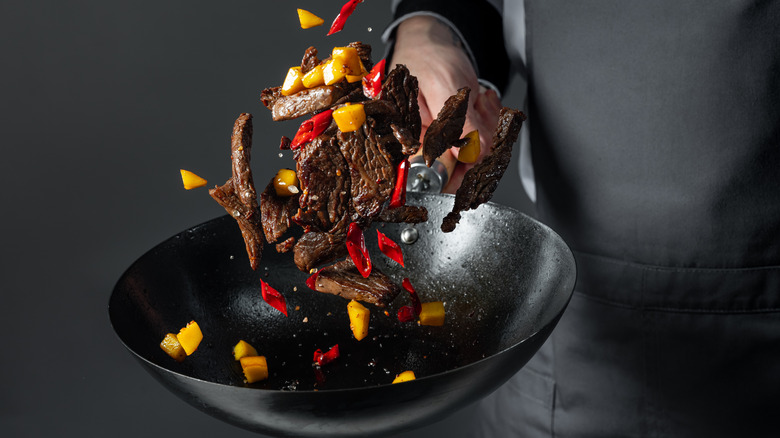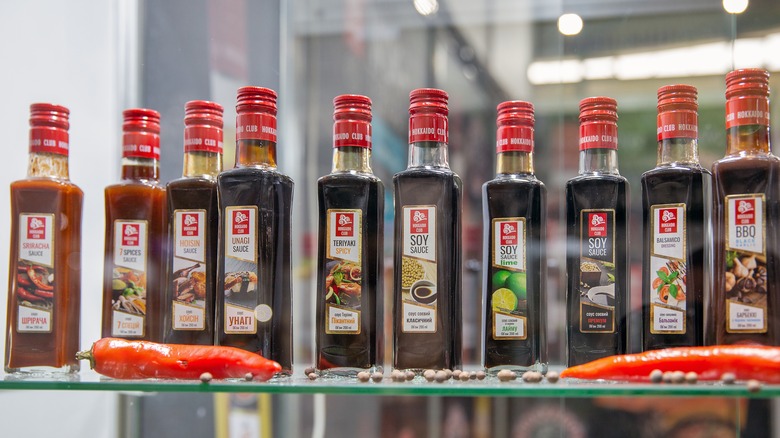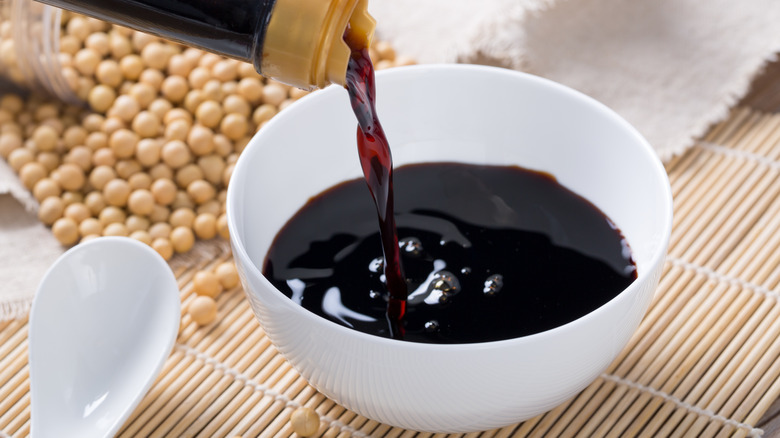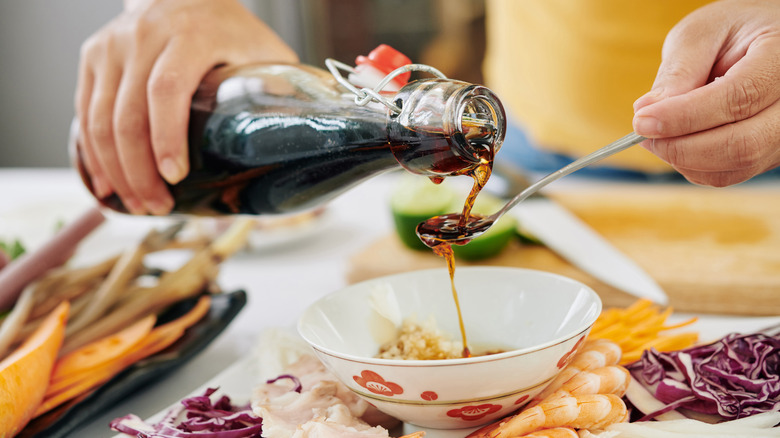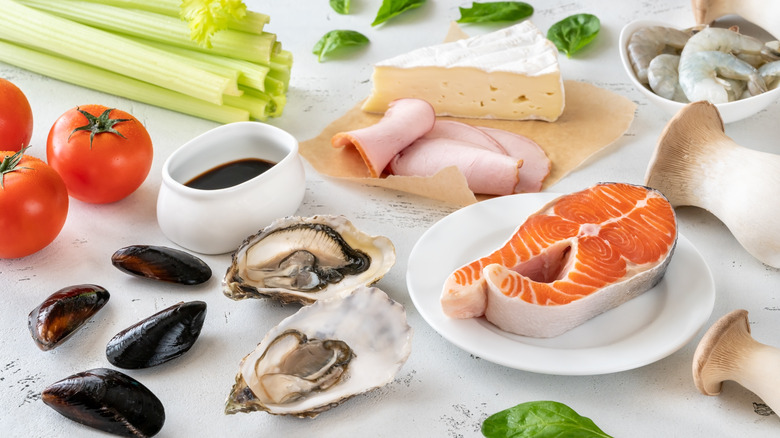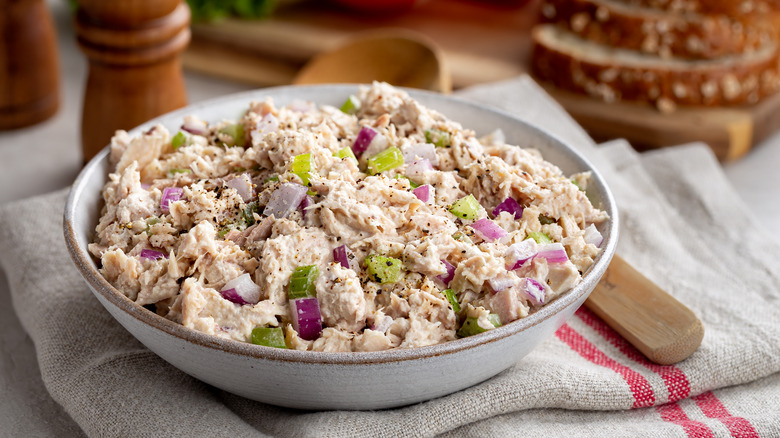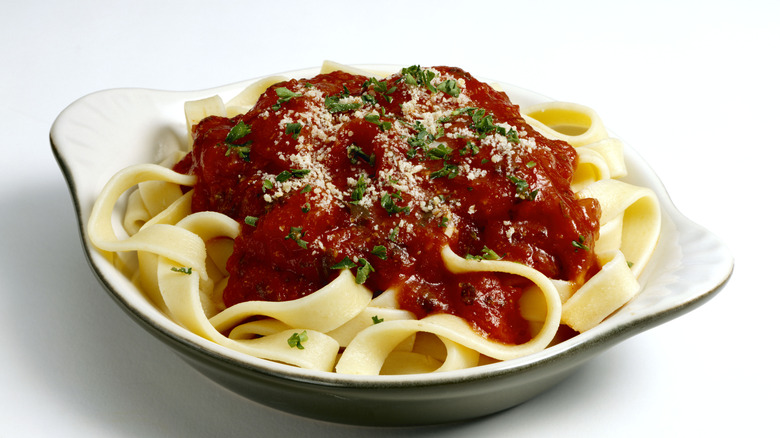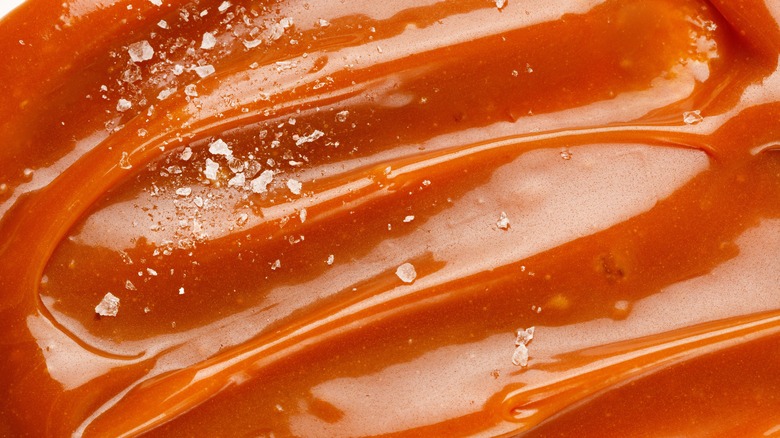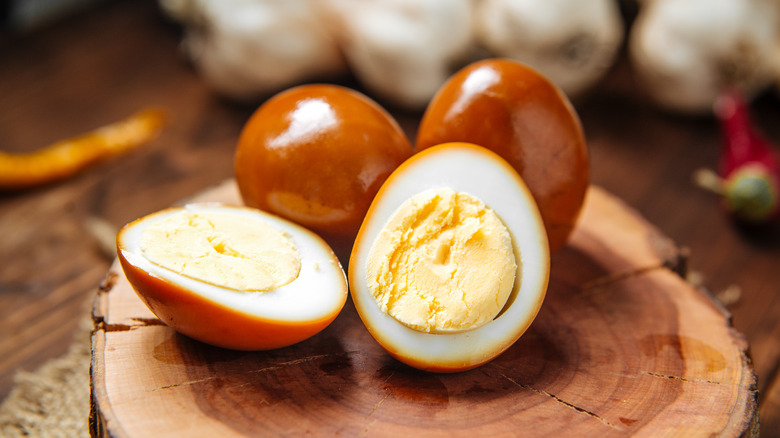14 Mistakes You're Making When Cooking With Soy Sauce
Soy sauce is a very popular seasoning, but also one with a rich history. It was created in ancient China as a less expensive alternative to salt. However, making soy sauce required a long time and a lot of work in the past, as it had to be mixed, fermented, and distilled four times.
Nowadays, soy sauce production has become a much easier task, but the demand has also increased significantly. Soy sauce is used in seasoning and cooking, as it can bring a rich, deep, umami flavor to any dish. However, consuming it in moderation is a must because soy sauce has a very high sodium content, which can cause serious health issues when eaten in excess. Therefore, the golden rule when cooking with soy sauce is to add it in small amounts and constantly taste. So, if you enjoy its rich flavor, avoid these common mistakes when cooking with soy sauce.
Not using the right kind of soy sauce
Soy sauce is one of the essential ingredients in many Asian cuisines, especially Chinese and Japanese. It is a dark, salty liquid made from fermented soybeans and wheat. Soy sauce adds flavor and depth to dishes, and different types of soy sauce are used for various purposes. Essentially, you should always use the specified type of soy sauce in your recipe, as they are not interchangeable and will change the taste and texture of your dish if you use another kind.
For example, there are Chinese and Japanese soy sauces and Indonesian and Thai. Second, inside each cuisine, there are several varieties of soy sauce. For instance, Chinese cuisine has light soy sauce, dark soy sauce, or mushroom-flavored soy sauce. Japanese cuisine has tamari, light and dark, and Indonesian cuisine has sweet soy sauce. These are all different in taste, flavor intensity, and sometimes texture, a set of features that will impact the consistency of your dish. So, when cooking with soy sauce, consider your recipe's cuisine and the type of soy sauce it requires.
Not adapting the soy sauce variety to your recipe
Gone are the days when people assumed soy sauce only meant the tiny package that came with your takeout sushi or Chinese food. Instead, inspired or coming directly from different Asian cuisines, soy sauce offers many variations and is suited to various recipes. So, take into consideration what your recipe says. But what to do when the recipe only says "soy sauce?" Using soy sauce in cooking boils down to these golden rules: Light soy sauce and all-purpose can be used in general recipes, and dark soy sauce is recommended when a recipe calls for it specifically. So, if you have a general "soy sauce" recipe, go with light.
Light and all-purpose soy sauce has a mild flavor and is moderately salty. It goes great in recipes such as chow mein, soups, fried rice, and stir-fry sauces. Dark soy sauce has a strong flavor and a mahogany color, and it goes well with lo mein noodles, kung pao chicken, and Thai stir-fried noodles. For dipping sauces and salad dressings, always go with the light variant, as the dark one is too strong. There are also seasoned soy sauces that go well in recipes that feature mushrooms. The Indonesian sweet soy sauce (kecap manis) is excellent in Indonesian dishes, such as nasi goreng or ketoprak.
Refrigerating it
Soy sauce is a fermented food that keeps well without being refrigerated. In addition, the salty environment of the sauce facilitates the growth of bacteria that create lactic acid, which stops the formation of pathogens. As a result, soy sauce can last indefinitely even if it's stored in the pantry and the bottle is not opened. The opened bottle, on the other hand, can last up to two years.
However, if you want to preserve the flavor, consider refrigerating soy sauce. When exposed to sources of light and heat, soy sauce's flavor may become less intense. Also, ensure that the bottle is tightly sealed so no harmful bacteria enter it. Finally, however unlikely soy sauce will go bad, you should always ensure that it tastes and smells good before using it. Examine how the sauce looks (it should have no floating particles), smell it (it should not smell rancid), and taste it. If all the flavors and textures are right, use the sauce.
Using the wrong substitute
Soy sauce adds umami, salty, and savory flavors to dishes. It's an essential ingredient in many recipes, but if you're out of soy sauce or can't eat it due to dietary restrictions, you may wonder what the best substitutes for soy sauce are. Fortunately, there are plenty of options to choose from, so the only aspects you should worry about are adapting the substitute to your recipe's flavor and texture profile.
The best soy sauce substitutes should bring both umami and saltiness to your dish. It would be best to consider the texture (you don't want to use miso paste or dried shiitake mushrooms in a recipe that calls for liquid ingredients, for example). As far as liquid substitutions are concerned, tamari, Worcestershire sauce, Maggi seasoning, fish sauce, oyster sauce, coconut aminos, and liquid aminos are the best options. For an intense umami flavor, try dry shiitake mushrooms, anchovies, miso paste, shrimp paste, or marmite. Tomato paste also has lots of umami but lacks some essential aspects of soy sauce. And, if none of these are lying around your pantry, use some salt.
Using too much and over-salting food
Soy sauce is a popular condiment, but over-salting food with soy sauce can potentially be dangerous. Excessive consumption of soy sauce has been linked to various health risks, including high blood pressure and kidney stones. In addition, over-salting food with soy sauce can lead to an unhealthy diet as it contains a high amount of sodium and other harmful additives. Therefore, it is vital to understand the risks associated with consuming too much soy sauce and how to use this flavorful condiment in moderation.
Although recipes sometimes indicate the soy sauce amount you should use, many home cooks disregard the indications. Another possible problem is that, for some people, the quantities in the recipes can seem too much. As such, the best solution is to add soy sauce gradually while cooking. Don't simply pour the entire amount into the dish at once. Instead, start small and keep adding until you find the taste to match what you like. The essential aspect when cooking is, after all, adhering to your preferences and maintaining your health.
Disregarding the gluten in soy sauce
It may come as a surprise to some people, but soy sauce is not gluten-free. The reason for this is the presence of wheat, an ingredient in some soy sauce recipes. Therefore, it can be unexpected for those who are intolerant to gluten or follow a gluten-free diet.
Gluten is found in wheat, barley, rye, and other grains. The protein binds together these grains, forming doughs and batters when mixed with a liquid such as water or milk. In traditional soy sauces, the wheat flour or starch used to ferment the soybeans contains gluten, meaning that most soy sauces contain some gluten unless labeled "gluten-free."
However, several soy sauce substitutes are entirely free from gluten. One of them is tamari, a Japanese sauce made from miso paste. Liquid aminos and coconut aminos are other gluten-free soy sauce substitutes. So, if you're avoiding gluten but are craving sushi or an umami boost, fear not, for there are still ways to get there.
Not balancing the flavors
When cooking with soy sauce, it's essential to consider the other flavors in the dish so that you don't overpower any of them. The key is to balance the salty and umami flavors with sweet and smoky ones. To achieve this balance, you can add sweet ingredients like honey or sugar and smoky ingredients like smoked paprika or mushrooms for a smoky flavor. In addition, if you're using flavored soy sauce, try adding ingredients that complement the aroma of the sauce. For example, smoke flavors can be added with mushroom-flavored soy sauce or other smoky ingredients, such as paprika or smoked sea salt. You could also use fresh herbs to brighten the dish and help round the taste profile.
Soy sauce is an incredibly versatile ingredient that can be used in various dishes. It has a distinct umami flavor; depending on your type, it can also be salty or sweet. A particular kind of soy sauce is Indonesian soy sauce. It is sweeter than Chinese or Japanese soy sauces because it has lots of added sugar. The texture is also different, as it somewhat resembles molasses. Indonesian soy sauce doesn't only work in Indonesian dishes but in other types of food, which can benefit from a strong and sweet flavor. Add it to scrambled eggs, tomato soup, or avocado toast, and enjoy the rich sweetness.
Not adding it to tuna salad
Soy sauce can be a valuable addition to tuna salad, as it improves the taste and gives it an umami richness. It's one of the best ingredients to add to tuna salad alongside Greek yogurt instead of mayo and jalapeño peppers. Making a tuna salad with soy sauce is a simple and flavorful way to enjoy a delicious and healthy meal. Soy sauce's salty and umami flavor makes it the perfect marinade for tuna. This dish is excellent as a light lunch or served alongside rice or noodles. It's also ideal as a dressing for banh mi sandwiches, adding an extra layer of flavor to the classic Vietnamese dish.
The best way to add soy sauce to tuna salad is to marinate the tuna in soy sauce for maximum flavor absorption. After this, you can add your favorite tuna salad ingredients. Also, remember the crunch (use some vegetables like cucumber, carrot, and radish) and the creaminess (mayo or Greek yogurt). Or you can make a dressing with Sriracha, yogurt, and soy sauce for a spicy, creamy combination.
Not using it as a seasoning in meat sauce for pasta
Although it is most commonly associated with Asian cuisine, soy sauce can enhance the flavor of Italian dishes such as pasta. Like in any other recipe, start by adding just a few drops of soy sauce to your pasta sauce to taste the new flavor. Soy sauce has a very salty taste and can overpower the other aromas in the dish if used in excess.
You can combine soy sauce with other sauces like Marinara or tomato sauce to add extra depth of flavor. When using soy sauce with pasta, it's important to remember that umami is an essential component of many dishes and that too much salt can affect your health. Soy sauce is especially good in pasta sauces containing meat or mushrooms, as the umami flavor is characteristic of these ingredients. Of course, you can always add more depth to the sauce by using ingredients such as red pepper flakes, dehydrated garlic, dried oregano, parsley, basil, or Italian seasoning. All in all, soy sauce works very well when flavoring pasta sauces, as many traditional ingredients also have that umami taste.
Ignoring it when enriching the taste of soups or stews
Soups and stews are versatile and filling dishes that allow many flavor and texture combinations. They're typically made with lots of ingredients and can welcome a number of flavoring options, from herbs and spices to tomato paste or different varieties of sauce. With soups and stews, umami is a flavor often overlooked, as umami-rich ingredients are not typically associated with these dishes. However, it turns out that playing around with umami ingredients, such as soy sauce, will only add depth to soups and stews.
Korean cuisine has a particular soy sauce type called soup soy sauce, which is specially used in soups. It has a light-brown color and a salty and savory taste, and it's preferably used in lighter-colored soup recipes. Soup soy sauce is a by-product of fermented soybean paste. Therefore, it is not identical to Korean soy sauce but represents a standalone variety of Korean soy sauce. Of course, soup soy sauce is not the only soy sauce variety you can use with soups and stews. You will have to adapt the soy sauce type to your ingredients and, of course, ensure that you are not over-seasoning your dish.
Failing to season roasted nuts with soy sauce
Who doesn't enjoy a bowl of freshly roasted nuts as a nutritious snack? You can use soy sauce to flavor roasted nuts, giving these treats a delicious flavor boost and crunch to your snacks.
You will only need a few ingredients to make roasted snacking nuts. First, you need to start with raw, unsalted nuts. You can use any variety of nuts for this recipe, such as almonds, walnuts, cashews, or peanuts. Then, toss the nuts in soy sauce until they are completely coated. Next, spread the coated nuts on a baking sheet and roast in the oven at 350 degrees Fahrenheit for about 10-15 minutes until golden brown and fragrant. Once your roasted snacking nuts are out of the oven, you can add some extra flavor with chili powder or other spices. You can also toast the nuts on medium heat in a skillet for an extra crunchy texture.
Neglecting to use soy sauce in desserts
As unlikely as it could seem, soy sauce is an excellent addition to desserts. The salty and umami flavor can bring out the best in some unexpected ingredients, such as caramel, vanilla, chocolate, mango, or coconut. Soy sauce desserts are very popular in Japanese cuisine, with unique ice cream mixes, crème caramel, or soy sauce and vanilla sponge roll.
In making soy sauce desserts, it's easiest to start with a caramel base. It provides the sweetness to balance out the savory taste of the soy sauce. For additional flavors, you can also use other ingredients, such as chocolate, coconut, or fruit. Start by preparing your caramel and melt it in a pan over low heat until it has a liquid-like consistency, then turn off the heat before adding in your chosen ingredients, such as chocolate chips or coconut flakes. Next, slowly add soy sauce to your mix while stirring gently with a spoon until everything is evenly combined. You can use this sauce as an ice cream addition, pudding flavor, or even add to a cake.
Forgetting to use it with eggs
Soy sauce and eggs make a great combination, as the flavors pair together nicely, and the eggs can only benefit from the soy sauce's rich umami and salty taste. You can use soy sauce to flavor eggs prepared in several ways, from scrambled to boiled, and the results will be very different. To make scrambled eggs with soy sauce, you will need some eggs, soy sauce, butter or oil, and salt and pepper. Begin by cracking the eggs into a bowl and whisking them together until they are thoroughly combined. Then heat some butter or oil in a pan over medium heat and add the egg mixture. Once it starts to set, stir in the soy sauce and season with salt and pepper to taste. Leave until the egg is fully cooked before serving hot.
You can also marinate eggs in soy sauce for a traditional ramen addition. Japanese soy sauce eggs have a deep brown color and a complex, part salty, part savory taste, alongside a creamy and complex texture. You can combine soy sauce with sherry vinegar, water, and sugar or use only boiled soy sauce. The eggs can be ready as fast as five minutes, depending on the preferred flavor intensity. Enjoy the soy-sauce marinated eggs as a standalone snack or on top of ramen.
Not mixing soy sauce with butter
A way to instantly elevate everything good about soy sauce is to mix it with butter. The warmth and luxury of butter enhance soy sauce's robust and savory flavor. Thus, soy butter becomes an ingredient that can improve any dish, be it meat, rice, or mushrooms. Or use the combination to butter a fresh slice of bread or toast.
There are countless ways to use soy butter in your cooking besides serving it as a simple spread. For example, you can cook steak in butter mixed with soy sauce (add a touch of ginger), add it to a satay sauce, or melt some soy butter in ramen broth and mix it with the noodles. Soy butter is an excellent addition to mushrooms, as they share the umami flavor. To make soy butter, add some drops of soy sauce to softened butter. If the soy taste seems too light, keep adding it, but always make sure to taste. Mix the two ingredients until creamy, and then enjoy your soy sauce butter any way you like.
Static Media owns and operates Mashed.


